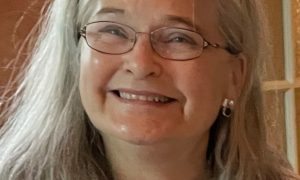by Taylor Choquette, intern, WSU ’18

Westfield State University professor Imo Imeh live painted a portrait of Trayvon Martin which was completed to coincide with Martin’s birthday (Photo by Taylor Choquette)
WESTFIELD – Throughout last week, artist and Westfield State professor Imo Imeh live painted a portrait of Trayvon Martin in the Dower Center performance space.
Trayvon Martin was a seventeen-year-old boy from Florida who was shot and killed in 2012 by George Zimmerman, a neighborhood watchman. Martin was unarmed and walking home from the store so he could watch a basketball game. His murder brought national attention to police brutality and killings, and other forms of abuse against black men in America.
Over the course of seventeen hours, starting Feb. 5, what would have been Martin’s twenty-third birthday, and ending in a discussion on Feb. 8, Imeh painted a large-scale picture in tribute.
On the final day of the live painting, the performance space was only lit by spotlights. Hanging on the brick walls behind the audience were photographs of black men who were wrongly killed or suffered other forms of abuse. The pictures, highlighted by the spotlights, also had blurbs written underneath, to educate the reader of what happened to men like Emmett Till and Michael Brown.
Imeh worked on his painting in the center of the space, with the largest spotlight shining on his work.

Westfield State professor and artist Imo Imeh has students hold the canvas as he paints a tribute to Trayvon Martin
(Photo by Taylor Choquette)
While finishing the painting, he invited students to write their message to Trayvon Martin on the canvas. Despite the room always having students watching the live painting, the only sound that could be heard was repeats of the news coverage from 2012 about Martin’s murder playing on a television in the corner.
The painting’s completion at 2 p.m. was followed by a performance and discussion at 4 p.m. Students and faculty filled the performance space, a crowd formed in the back when all the seats were full to watch as a choir sang and Imeh put the final touches on his painting.
When the choir stopped and he was finished, Imeh then stabbed the painting with a box cutter. He continued the performance by asking seventeen members of the audience to come up to the stage and cut the painting into seventeen pieces.
“It felt like I was hurting him. I felt uncomfortable with that,” said Anna Florczak, the fourteenth person to cut the portrait.

Westfield State professor and artist Imo Imeh holds a discussion after completing a painting in honor of Trayvon Martin
(Photo by Taylor Choquette)
“We all watched this grow for seventeen hours, like people watched Trayvon grow for seventeen years,” Imeh explained in a discussion led by Gina Beavers of the Valley Advocate.
“The sudden finish. At the end of seventeen hours it ends,” Imeh explained his decision to cut the painting, “it’s gone. That’s the point.”
With this project, Imeh’s idea was to create a platform for mourning, for celebration and for hope.
“With all the nonsense that happened last semester there can be grace,” Imeh further explained. He told the audience that this was not the end for this project. Imeh described the pieces of his painting as “seeds for hope,” and plans to create new projects with the seventeen pieces of his portrait of Trayvon Martin.








